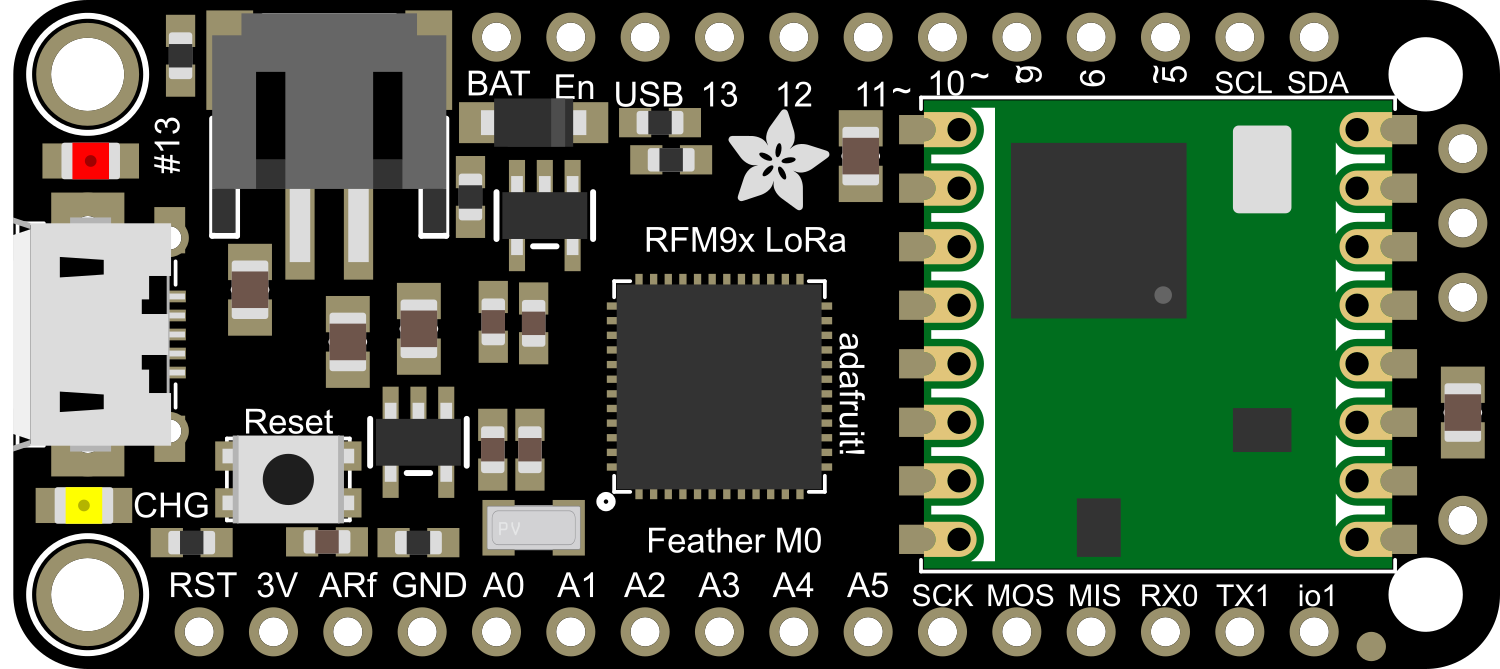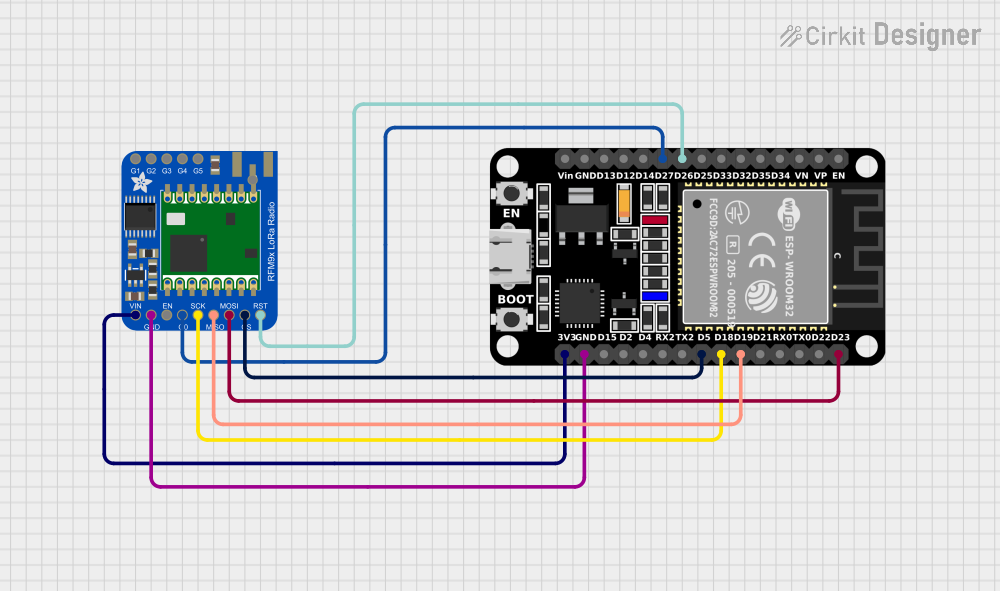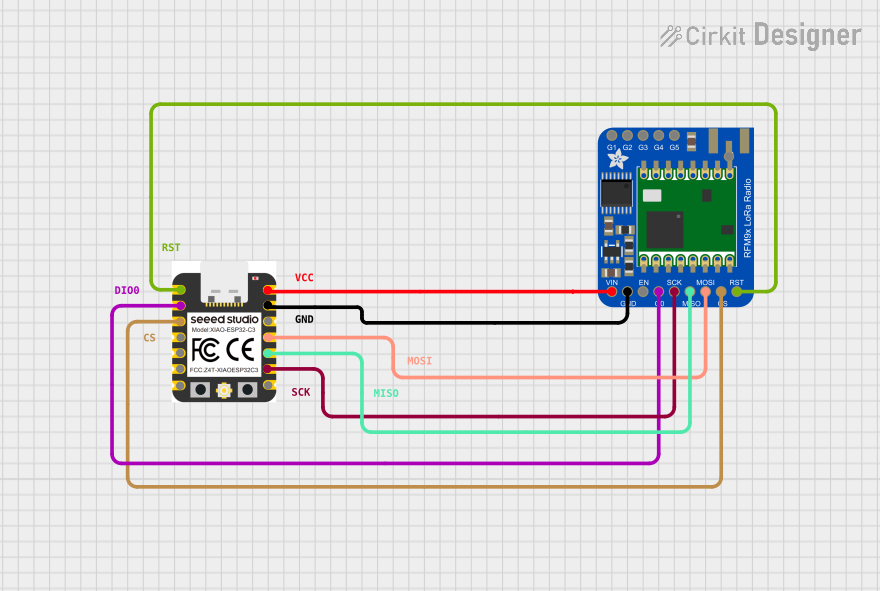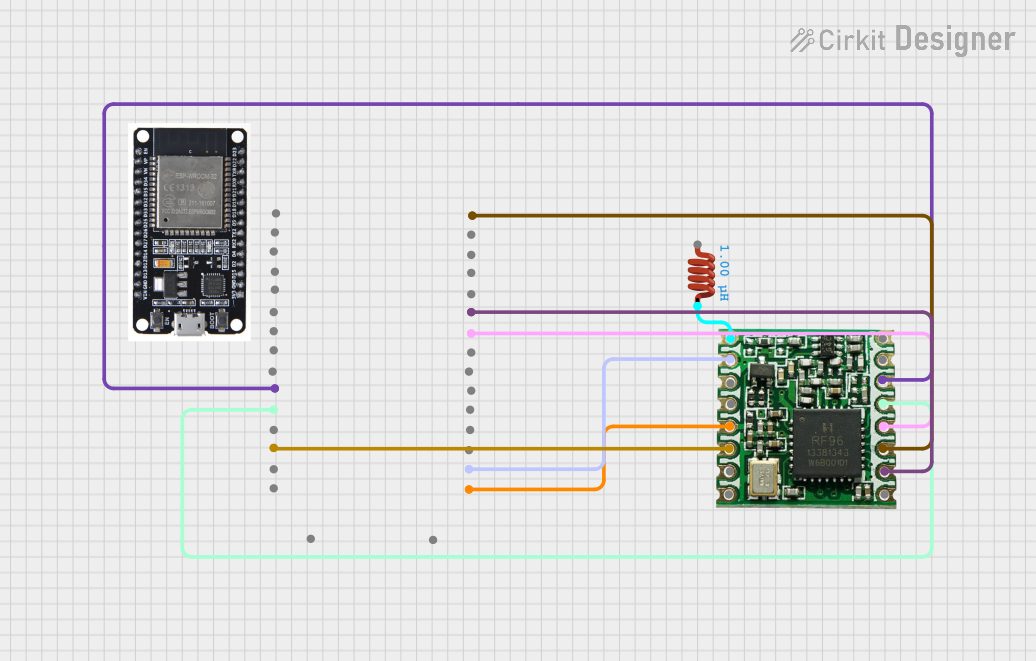
How to Use Adafruit Feather M0 RFM9x LoRa: Examples, Pinouts, and Specs

 Design with Adafruit Feather M0 RFM9x LoRa in Cirkit Designer
Design with Adafruit Feather M0 RFM9x LoRa in Cirkit DesignerIntroduction
The Adafruit Feather M0 RFM9x LoRa is a versatile, compact development board that combines the power of the ATSAMD21G18 ARM Cortex M0 microcontroller with the long-range communication capabilities of the RFM9x LoRa radio module. This board is ideal for projects requiring wireless data transmission over long distances with minimal power usage, such as remote sensors, home automation, and IoT applications.
Explore Projects Built with Adafruit Feather M0 RFM9x LoRa

 Open Project in Cirkit Designer
Open Project in Cirkit Designer
 Open Project in Cirkit Designer
Open Project in Cirkit Designer
 Open Project in Cirkit Designer
Open Project in Cirkit Designer
 Open Project in Cirkit Designer
Open Project in Cirkit DesignerExplore Projects Built with Adafruit Feather M0 RFM9x LoRa

 Open Project in Cirkit Designer
Open Project in Cirkit Designer
 Open Project in Cirkit Designer
Open Project in Cirkit Designer
 Open Project in Cirkit Designer
Open Project in Cirkit Designer
 Open Project in Cirkit Designer
Open Project in Cirkit DesignerTechnical Specifications
Microcontroller:
- Chip: ATSAMD21G18, 32-bit ARM Cortex M0+
- Clock Speed: 48 MHz
- Flash Memory: 256 KB
- SRAM: 32 KB
- Voltage: 3.3V logic and power
LoRa Radio:
- Frequency: 433 MHz or 868/915 MHz (region-specific)
- Modulation: LoRa spread spectrum
- Output Power: Up to +20 dBm
- Sensitivity: Down to -148 dBm
- Range: Up to 2 km with provided wire antenna (line-of-sight)
General:
- Operating Voltage: 3.7V to 6V (via LiPo battery or USB power)
- Battery Charging: 100mA lithium polymer battery charging via USB
- I/O Pins: 20 GPIO pins
- Interfaces: UART, I2C, SPI
- Analog Inputs: 6 x 12-bit ADC channels
- PWM Outputs: Up to 10
- Dimensions: 51mm x 23mm x 8mm
Pin Configuration and Descriptions
| Pin # | Function | Description |
|---|---|---|
| 1 | GND | Ground |
| 2 | 3V3 | 3.3V power supply output |
| 3 | AREF | Analog reference voltage for ADC |
| 4-9 | A0-A5 | Analog input pins |
| 10-17 | D0-D7 | Digital I/O pins |
| 18 | SCK | SPI clock |
| 19 | MISO | SPI Master In Slave Out |
| 20 | MOSI | SPI Master Out Slave In |
| 21 | RX | UART receive pin |
| 22 | TX | UART transmit pin |
| 23 | SDA | I2C data line |
| 24 | SCL | I2C clock line |
| 25 | RST | Reset pin |
| 26 | RFM9x_RST | LoRa radio module reset pin |
| 27 | RFM9x_CS | LoRa radio module chip select |
| 28 | RFM9x_INT | LoRa radio module interrupt pin |
| 29 | BAT | Battery voltage (analog input) |
| 30 | USB | USB data- |
| 31 | USB | USB data+ |
Usage Instructions
Integration into a Circuit
To integrate the Adafruit Feather M0 RFM9x LoRa into a circuit:
- Powering the Board: Connect a 3.7V LiPo battery for portable applications or power the board via the USB connection.
- Antenna: Attach the provided wire antenna to the ANT pin for LoRa communication.
- Programming: Use the micro USB port to connect the board to a computer for programming via the Arduino IDE.
- I/O Connections: Utilize the GPIO pins for connecting sensors, actuators, or other peripherals as required by your project.
Best Practices
- Always ensure that the power supply is within the specified range to prevent damage.
- When using the LoRa radio, ensure that the antenna is properly connected and positioned for optimal range.
- Follow ESD precautions when handling the board to avoid damaging the sensitive electronic components.
Example Code for Arduino UNO
Here is a basic example of how to send data using the LoRa radio on the Adafruit Feather M0 RFM9x LoRa. This code should be uploaded to the Feather M0 board.
#include <SPI.h>
#include <RH_RF95.h>
// Singleton instance of the radio driver
RH_RF95 rf95;
void setup() {
Serial.begin(9600);
while (!Serial) {
; // Wait for serial port to be available
}
if (!rf95.init()) {
Serial.println("LoRa radio init failed");
while (1);
}
Serial.println("LoRa radio init OK!");
if (!rf95.setFrequency(915.0)) {
Serial.println("setFrequency failed");
while (1);
}
rf95.setTxPower(13, false);
}
void loop() {
const char *msg = "Hello World!";
rf95.send((uint8_t *)msg, strlen(msg));
rf95.waitPacketSent();
Serial.println("Sent a message!");
delay(1000);
}
Ensure that you have the RadioHead library installed in your Arduino IDE to use the RH_RF95 class.
Troubleshooting and FAQs
Common Issues
- Board not recognized by computer: Check the USB cable and port. Try a different cable or port if necessary.
- LoRa communication failure: Ensure the antenna is properly connected and not damaged. Check the frequency and settings match between sender and receiver.
- Battery not charging: Verify the battery is properly connected and the USB port can supply sufficient current for charging.
FAQs
Q: Can I use the Feather M0 with a different frequency LoRa module? A: Yes, but ensure you have the correct version of the board for your region's frequency regulations.
Q: What is the maximum range I can achieve with the LoRa radio? A: The range can vary greatly depending on the environment, but with line-of-sight and proper antenna setup, you can achieve up to 2 km.
Q: How do I program the Feather M0? A: You can program it using the Arduino IDE. Select the 'Adafruit Feather M0' board from the board manager.
For further assistance, consult the Adafruit Feather M0 RFM9x LoRa forums and support channels.